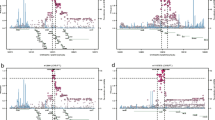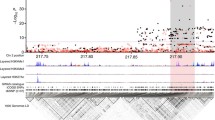Abstract
The aim of this study was to identify candidate single-nucleotide polymorphisms (SNPs) that might affect susceptibility to breast cancer and then elucidate their potential mechanisms and generate SNP-to-gene-to-pathway hypotheses. A genome-wide association study (GWAS) dataset of breast cancer that included 453,852 SNPs from 1,145 breast cancer patients and 1,142 control subjects of European descent was used in this study. The identify candidate causal SNPs and pathways (ICSNPathway) method was applied to the GWAS dataset. ICSNPathway analysis identified 16 candidate SNPs, 13 genes, and 7 pathways, which together revealed 7 hypothetical biological mechanisms. The strongest hypothetical biological mechanism was that rs3168891 and rs2899849 alter the role of MBIP in the inactivation of mitogen-activated protein kinase (MAPK) (p < 0.001; false discovery rate (FDR) = 0.038). The second strongest mechanism was that rs2229714 modulates RPS6KA1 to affect its role in growth hormone signaling (p = 0.001; FDR = 0.039). The third strongest mechanism was that rs2230394 modulates ITGB1 to regulate the PTEN pathway and hsa04360 (axon guidance pathway) (p < 0.001; FDR = 0.039, 0.041). Use of the ICSNPathway to analyze breast cancer GWAS data identified 16 candidate SNPs, 13 genes (including MBIP, RPS6KA1, and ITGB1), and 7 pathways that might contribute to the susceptibility of patients to breast cancer.

Similar content being viewed by others
References
Kamangar F, Dores GM, Anderson WF. Patterns of cancer incidence, mortality, and prevalence across five continents: defining priorities to reduce cancer disparities in different geographic regions of the world. J Clin Oncol. 2006;24(14):2137–50.
Easton DF. How many more breast cancer predisposition genes are there? Breast Cancer Res. 1999;1(1):14–7.
Njiaju UO, Olopade OI. Genetic determinants of breast cancer risk: a review of current literature and issues pertaining to clinical application. Breast J. 2012;18(5):436–42.
Manolio TA. Genomewide association studies and assessment of the risk of disease. N Engl J Med. 2010;363(2):166–76.
Johnson AD, O'Donnell CJ. An open access database of genome-wide association results. BMC Med Genet. 2009;10:6.
Wei P, Tang H, Li D. Insights into pancreatic cancer etiology from pathway analysis of genome-wide association study data. PLoS One. 2012;7(10):e46887.
Wang K, Li M, Hakonarson H. Analysing biological pathways in genome-wide association studies. Nat Rev Genet. 2010;11(12):843–54.
Lee YH, Song GG. Pathway analysis of genome-wide association studies on uric acid concentrations. Hum Immunol. 2012;73(8):805–10.
Lee YH, Bae SC, Choi SJ, Ji JD, Song GG. Genome-wide pathway analysis of genome-wide association studies on systemic lupus erythematosus and rheumatoid arthritis. Mol Biol Rep. 2012;39(12):10627–35.
Zhang K, Chang S, Cui S, Guo L, Zhang L, Wang J. ICSNPathway: identify candidate causal SNPs and pathways from genome-wide association study by one analytical framework. Nucleic Acids Res. 2011;39(Web Server issue):W437–43.
Hunter DJ, Kraft P, Jacobs KB, Cox DG, Yeager M, Hankinson SE, et al. A genome-wide association study identifies alleles in FGFR2 associated with risk of sporadic postmenopausal breast cancer. Nat Genet. 2007;39(7):870–4.
International HapMap C, Altshuler DM, Gibbs RA, Peltonen L, Altshuler DM, Gibbs RA, et al. Integrating common and rare genetic variation in diverse human populations. Nature. 2010;467(7311):52–8.
Kanehisa M, Goto S, Furumichi M, Tanabe M, Hirakawa M. KEGG for representation and analysis of molecular networks involving diseases and drugs. Nucleic Acids Res. 2010;38(Database issue):D355–60.
Ashburner M, Ball CA, Blake JA, Botstein D, Butler H, Cherry JM, et al. Gene ontology: tool for the unification of biology. The Gene Ontology Consortium. Nat Genet. 2000;25(1):25–9.
Johnson AD, Handsaker RE, Pulit SL, Nizzari MM, O'Donnell CJ, de Bakker PI. SNAP: a web-based tool for identification and annotation of proxy SNPs using HapMap. Bioinformatics. 2008;24(24):2938–9.
Choi SJ, Rho YH, Ji JD, Song GG, Lee YH. Genome scan meta-analysis of rheumatoid arthritis. Rheumatology (Oxford). 2006;45(2):166–70.
Lee YH, Nath SK. Systemic lupus erythematosus susceptibility loci defined by genome scan meta-analysis. Hum Genet. 2005;118(3–4):434–43.
Zeggini E, Ioannidis JP. Meta-analysis in genome-wide association studies. Pharmacogenomics. 2009;10(2):191–201.
Elbers CC, van Eijk KR, Franke L, Mulder F, van der Schouw YT, Wijmenga C, et al. Using genome-wide pathway analysis to unravel the etiology of complex diseases. Genet Epidemiol. 2009;33(5):419–31.
Fridley BL, Biernacka JM. Gene set analysis of SNP data: benefits, challenges, and future directions. Eur J Hum Genet. 2011;19(8):837–43.
Pedroso I, Breen G. Gene set analysis and network analysis for genome-wide association studies. Cold Spring Harb Protoc. 2011;2011(9).
Fukuyama K, Yoshida M, Yamashita A, Deyama T, Baba M, Suzuki A, et al. MAPK upstream kinase (MUK)-binding inhibitory protein, a negative regulator of MUK/dual leucine zipper-bearing kinase/leucine zipper protein kinase. J Biol Chem. 2000;275(28):21247–54.
Aguirre-Ghiso JA, Estrada Y, Liu D, Ossowski L. ERK(MAPK) activity as a determinant of tumor growth and dormancy; regulation by p38(SAPK). Cancer Res. 2003;63(7):1684–95.
Li D, Fu TM, Nan J, Liu C, Li LF, Su XD. Structural basis for the autoinhibition of the C-terminal kinase domain of human RSK1. Acta Crystallogr D Biol Crystallogr. 2012;68(Pt 6):680–5.
Anjum R, Blenis J. The RSK family of kinases: emerging roles in cellular signalling. Nat Rev Mol Cell Biol. 2008;9(10):747–58.
Xu J, Zhang Y, Berry PA, Jiang J, Lobie PE, Langenheim JF, et al. Growth hormone signaling in human T47D breast cancer cells: potential role for a growth hormone receptor-prolactin receptor complex. Mol Endocrinol. 2011;25(4):597–610.
Luu NT, Glen KE, Egginton S, Rainger GE, Nash GB. Integrin-substrate interactions underlying shear-induced inhibition of the inflammatory response of endothelial cells. Thromb Haemost. 2013;109(2):298–308.
DeGraffenried LA, Fulcher L, Friedrichs WE, Grunwald V, Ray RB, Hidalgo M. Reduced PTEN expression in breast cancer cells confers susceptibility to inhibitors of the PI3 kinase/Akt pathway. Ann Oncol. 2004;15(10):1510–6.
Harburg GC, Hinck L. Navigating breast cancer: axon guidance molecules as breast cancer tumor suppressors and oncogenes. J Mammary Gland Biol Neoplasia. 2011;16(3):257–70.
Acknowledgments
The authors gratefully acknowledge investigators, for sharing their valuable GWAS data.
Conflicts of interest
None
Author information
Authors and Affiliations
Corresponding author
Rights and permissions
About this article
Cite this article
Lee, Y.H., Kim, JH. & Song, G.G. Genome-wide pathway analysis of breast cancer. Tumor Biol. 35, 7699–7705 (2014). https://doi.org/10.1007/s13277-014-2027-5
Received:
Accepted:
Published:
Issue Date:
DOI: https://doi.org/10.1007/s13277-014-2027-5




